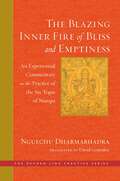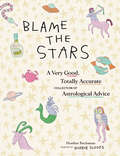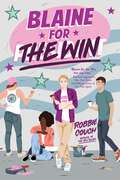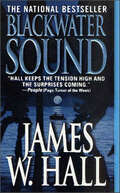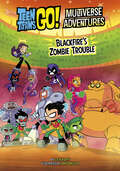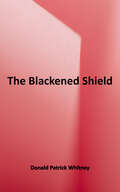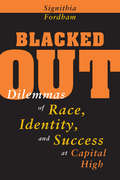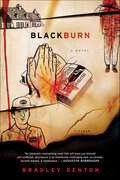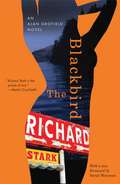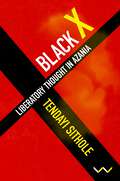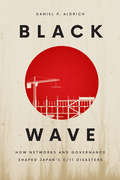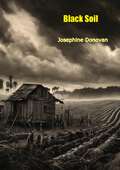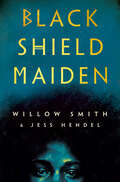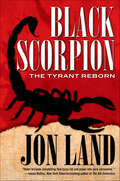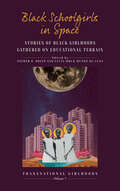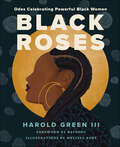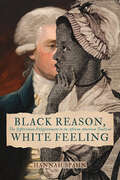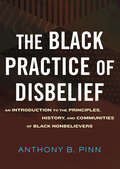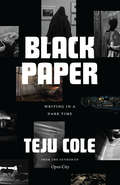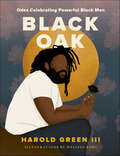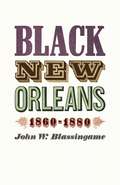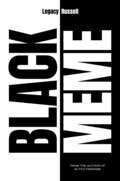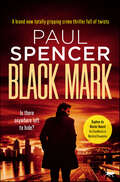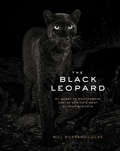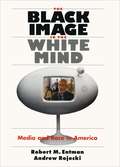- Table View
- List View
The Blazing Inner Fire of Bliss and Emptiness: An Experiential Commentary on the Practice of the Six Yogas of Naropa (The Dechen Ling Practice Series)
by David GonsalezA set of commentaries that present some of the most rarefied and secret teachings within Tibetan Buddhism from the perspective of the Dalai Lama&’s Gelug school.The Blazing Inner Fire of Bliss and Emptiness presents lucid translations of a pair of detailed commentaries by the famed Tibetan tantric master Ngulchu Dharmabhadra (1772–1851), illuminating a set of extremely secret and restricted tantric practices of highest yoga tantra. The first of these commentaries details the practices of the Six Yogas of Naropa, one of the most celebrated and revered systems of completion-stage practice in Tibet. Dharmabhadra presents the Six Yogas by elaborating upon Lama Tsongkhapa&’s (1357–1419) masterpiece on the subject entitled Endowed with the Three Inspirations, which served as the basis for nearly all subsequent commentaries on the Six Yogas within the Gelug tradition. Ngulchu Dharmabhadra&’s commentary is unique in that it presents the Six Yogas within the context of Vajrayogini practice, making this book a perfect companion piece to The Extremely Secret Dakini of Naropa (Wisdom Publications, 2020). Also contained in this book is Ngulchu Dharmabhadra&’s lucid and concise commentary on the First Panchen Lama&’s (1570–1662) famous Supplication for Liberation from [Fear of] the Perilous Journey of the Intermediate State. The prayer—a beautiful literary contribution from the First Panchen Lama in its own right—invokes the immediacy of death and the potential to use the process of dying as an opportunity for liberation. The prayer extols the efficacy of the &“nine mixings&” of the completion stage as direct means of transforming our ordinary death process by using advanced yogas presented in the first commentary on the Six Yogas. Together, these works present the reader with a vast and profound vision of spiritual transformation—one in which every aspect of human experience can be used as an opportunity for transcendence and spiritual liberation.
Blame the Stars: A Very Good, Totally Accurate Collection of Astrological Advice
by Heather BuchananPart surrealism, part humor, and part affectionate guidance, Blame the Stars is a wild adventure into a world of uniquely alternative zodiac signs.Welcome to the world of Horror Scoops: a weird and wonderful twist on classic zodiac signs. Meet passionate and wild Lemo (a.k.a. Leo), kind Lehbrah (Libra), steadfast Clopricrumb (Capricorn), Germini the Twrnnns (take two guesses), and others—signs which, although slightly silly, reveal more about us than we realize.Part One dives deep into each sign, offering insightful tidbits and advice on love, life, and work (for example, if you’re an Arbys, consider a career as a Pie-Eating Competition Judge, a Horse Observer, or a Horse Observer Observer). Part Two details a year’s worth of sign-specific guidance, Scoop-holidays (like January 15, the Day of Remembrance for Fallen Houseplants), and journal prompts to spark deep introspection. Full of colorful illustrations from Scoops creator and accidental astrologer Heather Buchanan, lots of entertaining nonsense, and occasional sense-sense, Blame the Stars offers the ideal way to contemplate the mysteries of the universe (or have a giggle). FOR ASTROLOGY FANS: Horoscope and astrology are deeply engrained in society. This modern divination book stands out as a playful and interactive option that will appeal to people who dig astrology but don't take it all too seriously (because life is serious enough).FROM THE CREATOR OF WILDLY POPULAR HORROR SCOOPS: Author Heather Buchanan has been creating and sharing her absurdist horoscopes for years to her hundreds of thousands of fans. This is the book those fans have been waiting for, capturing for the first time all the wild, insightful, colorful signs and observations they love in one volume. RELATABLE AND QUIRKY HUMOR: There is a genuine feeling of joy behind the absurd, offbeat humor of this horoscope book. While some astrological-themed metaphysical books may be more serious, this one feels approachable, engaging, and just plain fun.Perfect for:Fans of Horror Scoops and Heather Buchanan's work Astrology devotees (and the astrology-curious) who don't take themselves too seriously People interested in lighthearted self-helpFollowers of social media horoscope accounts and brands like Bitch Rising, Co-Star, That Libra Chic, and moreGift-giving to any astrology lover for birthday, anniversary, or just for fun
Blaine for the Win
by Robbie CouchAfter being dumped so his boyfriend can pursue more &“serious&” guys, a teen boy decides to prove he can be serious, too, by running for senior class president in this &“clever, fun, original&” (BCCB) romp from the author of The Sky Blues.High school junior Blaine Bowers has it all—the perfect boyfriend, a pretty sweet gig as a muralist for local Windy City businesses, a loving family, and awesome, talented friends. And he is absolutely, 100% positive that aforementioned perfect boyfriend—senior student council president and Mr. Popular of Wicker West High School, Joey—is going to invite Blaine to spend spring break with his family in beautiful, sunny Cabo San Lucas. Except Joey breaks up with him instead. In public. On their one-year anniversary. Because, according to Joey, Blaine is too goofy, too flighty, too…unserious. And if Joey wants to go far in life, he needs to start dating more serious guys. Guys like Zach Chesterton. Determined to prove that Blaine can be what Joey wants, Blaine decides to enter the running to become his successor (and beat out Joey&’s new boyfriend, Zach) as senior student council president. But is he willing to sacrifice everything he loves about himself to do it?
Blackwater Sound: A Novel (Thorn Series #4)
by James W. HallThe Braswell family had everything people would kill for: money, looks, power. But their eldest son, the family's shining light, died in a bizarre fishing accident. And when he disappeared-hauled into the depths by the giant marlin he had been fighting-he took with him a secret so corrupt that it could destroy the Braswells. Ten years later, a huge airliner crashes in the steamy shallows off the Florida coast, killing all aboard. Helping pull bodies from the water, Thorn finds himself drawn into a bizarre conspiracy: someone has developed a high tech weapon capable of destroying electrical systems in a powerful flash. The terrorist potential is huge. How are the secretive Braswells and their family-owned company, MicroDyne, involved? And what does it have to do with the family's obsessive hunt for the great marlin that killed their golden boy? With the Braswells, James W. Hall introduces one of the most evil and dysfunctional families in the history of fiction. And, along with Thorn, he brings back favorite characters from his earlier books, including Alexandra Rafferty and her father, Lawton Collins, a retired and increasingly dotty former police investigator whose methods of investigation result in his kidnapping. A story that bristles with all the heat and tension of a tropical Florida summer, Blackwater Sound is destined to rank among the greatest suspense thrillers of the new decade.
Blackfire’s Zombie Trouble (Teen Titans Go! Multiverse Adventures Ser.)
by Steve KortéWhen Beast Boy uses Raven’s spell book, he conjures a hole in the Multiverse that brings the Zombie Titans to town. If that wasn’t bad enough, a terrifying text from Tamaran alerts Starfire that her evil sister is up to no good. It’s a diabolical double whammy! Can the Teen Titans battle Blackfire and zombies at the same time? Or will they throw up their hands and become a brain buffet for their undead counterparts? Find out in this hilariously mixed-up Multiverse chapter book for fans of Teen Titans Go!
The Blackened Shield
by Donald Patrick WhitneyFrom DJ flap - The shield of a firefighter's helmet gets blackened from experience, from meeting the challenges and confronting the dangers of the job day after day, night after night, from taking walking tours of hell with the devil as your guide. The author worked as a firefighter in one of New England's oldest, most densely populated cities during perhaps the most challenging period in the history of the American fire service, the '60s, '70s, and early 80s.
Blacked Out: Dilemmas of Race, Identity, and Success at Capital High
by Signithia FordhamThis innovative portrait of student life in an urban high school focuses on the academic success of African-American students, exploring the symbolic role of academic achievement within the Black community and investigating the price students pay for attaining it. Signithia Fordham's richly detailed ethnography reveals a deeply rooted cultural system that favors egalitarianism and group cohesion over the individualistic, competitive demands of academic success and sheds new light on the sources of academic performance. She also details the ways in which the achievements of sucessful African-Americans are "blacked out" of the public imagination and negative images are reflected onto black adolescents. A self-proclaimed "native" anthropologist, she chronicles the struggle of African-American students to construct an identity suitable to themselves, their peers, and their families within an arena of colliding ideals. This long-overdue contribution is of crucial importance to educators, policymakers, and ethnographers.
Blackburn: A Novel
by Bradley DentonJimmy Blackburn grows up in the Midwest believing the things that adults tell him. He questions his teachers and they lie to him. He questions his parents and his father beats him. He questions the world and it hurts him.And so Jimmy Blackburn becomes a killer.In this novel we meet many of Blackburn's twenty-one victims. They include law enforcers, writers, adulterers, auto mechanics, and other liars.This is an exceptional novel, at once riotously funny and searingly potent: a vision of America through the eyes of the central bogeyman of our culture.
The Blackbird: An Alan Grofield Novel
by Richard StarkDonald E. Westlake is one of the greats of crime fiction. Under the pseudonym Richard Stark, he wrote twenty-four fast-paced, hardboiled novels featuring Parker, a shrewd career criminal with a talent for heists. Using the same nom de plume, Westlake also completed a separate series in the Parker universe, starring Alan Grofield, an occasional colleague of Parker. While he shares events and characters with several Parker novels, Grofield is less calculating and more hot-blooded than Parker; think fewer guns, more dames. Not that there isn’t violence and adventure aplenty. The third Grofield novel, The Blackbird shares its first chapter with Slayground: after a traumatic car crash, Parker eludes the police, but Grofield gets caught. Lying injured in the hospital, Grofield is visited by G-Men who offer him an alternative to jail, and he finds himself forced into a deadly situation involving international criminals and a political conspiracy. With a new foreword by Sarah Weinman that situates the Grofield series within Westlake’s work as a whole, this novel is an exciting addition to any crime fiction fan’s library.
Black X: Liberatory thought in Azania
by Tendayi SitholeWhat does it mean to be Black in an anti-Black world?In Black X: Liberatory Thought in Azania, Tendayi Sithole offers a compelling example of how to engage South Africa differently. Set in the Black point of view as a site of critical reflection, he confronts the question of colonial conquest, social cohesion and justice. Since South Africa is a name given to the country by its conquerors, not by its indigenous inhabitants, for true liberation, a renaming needs to occur. The concept of Azania holds this emancipatory gesture.The post conquest, post 1994 liberal narratives mute the prevalence of racism while valorizing non-racialism and the transcendence of race. To indicate this silencing, the book deploys the concept of X, both as a signifier of repression and dehumanization of the Black subject, and as an empty signifier that holds the opportunity for radical and compassionate rehumanization.The book examines these strands of erasure and hope for the Black subject. Sithole scrutinizes the colonial contract, arguing that it is not a contract since there has never been an agreement between the indigenous people and the settler colonialists. This brings into focus the land question, specifically land dispossession and its existential connection to black life. The relevance of Black Consciousness to the Azanian existential tradition is based on Steve Biko’s case that Marxism ignores Black ontological misery through its valorization of class and failure to include anti-Black racism in its analysis of power. Finally, Sithole analyses Mabogo P. More’s philosophical meditations around what it means to be Black in an anti-Black world.In erasing the idea of South Africa and inscribing an open-ended naming of X, the book opens the way for something new to take its place that is imbued with greater humanity. This gesture opens up the potential to think about liberation in this country that is yet to rename and redefine itself.
Black Wave: How Networks and Governance Shaped Japan’s 3/11 Disasters
by Daniel P. AldrichDespite the devastation caused by the magnitude 9.0 earthquake and 60-foot tsunami that struck Japan in 2011, some 96% of those living and working in the most disaster-stricken region of Tohoku made it through. Smaller earthquakes and tsunamis have killed far more people in nearby China and India. What accounts for the exceptionally high survival rate? And why is it that some towns and cities in the Tohoku region have built back more quickly than others? Black Wave illuminates two critical factors that had a direct influence on why survival rates varied so much across the Tohoku region following the 3/11 disasters and why the rebuilding process has also not moved in lockstep across the region. Individuals and communities with stronger networks and better governance, Daniel P. Aldrich shows, had higher survival rates and accelerated recoveries. Less-connected communities with fewer such ties faced harder recovery processes and lower survival rates. Beyond the individual and neighborhood levels of survival and recovery, the rebuilding process has varied greatly, as some towns and cities have sought to work independently on rebuilding plans, ignoring recommendations from the national government and moving quickly to institute their own visions, while others have followed the guidelines offered by Tokyo-based bureaucrats for economic development and rebuilding.
Black Soil
by Professor Josephine Donovan“Black Soil is a novel written by Josephine Donovan, which tells the story of a young woman named Ella Mae Turner, who is forced to confront the harsh realities of racism and discrimination in the American South during the 1930s. Ella Mae is a strong-willed and determined character, who is determined to make a better life for herself and her family, despite the many obstacles that stand in her way. The novel is set in the fictional town of Cottondale, Georgia, where Ella Mae and her family live and work on a small farm. The Turners are a hardworking and close-knit family, but they are also poor and struggling to make ends meet. Ella Mae dreams of a better life, and she is determined to make it happen, even if it means leaving her family behind. As the story unfolds, Ella Mae faces many challenges and obstacles, including racism, poverty, and violence. She is forced to confront the harsh realities of life in the South, where black people are treated as second-class citizens and are often subjected to violence and discrimination. Despite these challenges, Ella Mae remains determined to succeed, and she eventually leaves Cottondale to pursue her dreams. Along the way, she meets many other characters who are also struggling to survive in a world that is often cruel and unfair. Black Soil is a powerful and moving novel that explores the themes of race, class, and identity in the American South. It is a story of resilience, courage, and hope, and it offers a powerful commentary on the enduring legacy of racism and discrimination in America.”-Print ed.
Black Shield Maiden
by Willow Smith Jess HendelFrom Willow Smith and Jess Hendel comes a powerful and groundbreaking historical saga about an African warrior in the world of the Vikings.&“Intimate, tender, and fiercely epic.&”—Tomi Adeyemi, author of Children of Blood and BoneLore, legend, and history tell us of the Vikings: warrior kings on epic journeys of conquest and plunder. But the stories we know are not the only stories to tell. There is another story, one that has been lost to the mists of time: the saga of the dark queen. This saga begins with Yafeu, a defiant yet fiercely compassionate young warrior who is stolen from her home in the flourishing Ghānaian empire and taken to a distant kingdom in the North. There she is thrust into a strange, cold world of savage shield maidens, tyrannical rulers, and mysterious gods.And there she also finds something unexpected: a kindred spirit. She comes to serve Freydis, a shy princess who couldn&’t be more different from the confident and self-possessed Yafeu. But they both want the same thing: to forge their own fate. Yafeu inspires Freydis to dream of a future greater than the one that the king and queen have forced upon her. And with the princess at her side, Yafeu learns to navigate this new world and grows increasingly determined to become one of the legendary shield maidens—to fight not only for her freedom but for the freedom of others.Yafeu may have lost her home, but she still knows who she is, and she&’s not afraid to be the flame that burns a city to the ground so a new world can rise from the ashes. She will alter the course of history—and become the revolutionary heroine of her own myth.
Black Scorpion: The Tyrant Reborn (Michael Tiranno: The Tyrant #2)
by Jon LandThe next adventure of The Seven Sins' Michael "The Tyrant" Tiranno, Jon Land's Black Scorpion is a pulse pounding action-thriller as he takes on a worldwide human trafficking cabal.Five years have passed since Michael Tiranno saved the city of Las Vegas from a terrorist attack. And now a new enemy has surfaced in Eastern Europe in the form of an all-powerful organization called Black Scorpion. Once a victim of human trafficking himself, the shadowy group's crazed leader, Vladimir Dracu, has become the mastermind behind the scourge's infestation on a global scale. And now he's set his sights on Michael Tiranno for reasons birthed in a painful secret past that have scarred both men.Already facing a myriad of problems, Michael once more must rise to the challenge of confronting an all-powerful enemy who is exploiting and ravaging innocents all across the globe and has set nothing less than all of America as its new victim. Black Scorpion has also taken the woman Michael loves hostage: Scarlett Swan, a beautiful archaeologist who was following the dangerous trail of the origins of the ancient relic that both defines and empowers Michael, a discovery that could change history and the perception of mankind's very origins.With the deck and the odds stacked against him, Michael must come to learn and embrace his true destiny in becoming the Tyrant reborn as a dark knight to triumph over ultimate evil and stop the sting of Black Scorpion from undermining all of the United States and plunging Las Vegas into chaos and anarchy.Writer/director Chuck Russell has been attached to The Seven Sins, an upcoming film based on a blended adaptation of The Seven Sins: The Tyrant Ascending and Black Scorpion: the Tyrant Reborn.At the Publisher's request, this title is being sold without Digital Rights Management Software (DRM) applied.
Black Schoolgirls in Space: Stories of Black Girlhoods Gathered on Educational Terrain (Transnational Girlhoods #7)
by Esther O. Ohito and Lucía Mock Muñoz de LunaLocating Black girls’ desires, needs, knowledge bases, and lived experiences in relation to their social identities has become increasingly important in the study of transnational girlhoods. Black Schoolgirls in Space pushes this discourse even further by exploring how Black girls negotiate and navigate borders of blackness, gender, and girlhood in educational spaces. The contributors of this collected volume highlight Black girls as actors and agents of not only girlhood but also the larger, transnational educational worlds in which their girlhoods are contained.
Black Roses: Odes Celebrating Powerful Black Women
by Harold GreenThe poet and founder of the music collective Flowers for the Living pays tribute to all Black women by focusing on visionaries and leaders who are making history right now, including Ava DuVernay, Janelle Monae, Kamala Harris, Misty Copeland, Nikole Hannah-Jones, Robin Roberts, Roxane Gay, and Simone Biles—with this compilation of celebratory odes featuring full-color illustrations by Melissa Koby.Black women are exceptional. To honor how Black women use their minds, talent, passion, and power to transform society, Harold Green began writing love letters in verse which he shared on his Instagram account. Balm for our troubled times, his tributes to visionaries and leaders quickly went viral and became a social media sensation. Now, in this remarkable collection, Green brings together many of these popular odes with never-before-seen works. A timely celebration of contemporary Black figures who are making history and shaping our culture today, Black Roses is divided into five sections—advocates, curators, innovators, luminaries, trailblazers—reflecting the diversity of Black women’s achievements and the depth of their reach. These inspiring changemakers are leaving their mark on the world by creating new beauty in their respective art forms, heading movements, fighting for equality and to change the status quo, and championing new definitions of what’s possible in every meaningful way. Green lifts them up to create meaningful connections between these figures and our own lives and experiences.Black Roses spotlights and urges readers to learn more about Allyson Felix, Angelica Ross, Ava DuVernay, Bisa Butler, Bozoma Saint John, Charisma Sweat-Green, Dr. Eve Ewing, Dr. Janice Jackson, Dr. Johnnetta Cole, Eunique Jones-Gibson, Issa Rae, Janelle Monae, Jennifer Hudson, Jessica Matthews, Kamala Harris, Keisha Bottoms, Kimberly Bryant, Kimberly Drew, Lisa Green, Lizzo, Mandilyn Graham, Mellody Hobson, Michelle Alexander, Misty Copeland, Naomi Beckwith, Nikole Hannah-Jones, Phylicia Rashad, Rapsody, Raquel Willis, Robin Roberts, Roxane Gay, Shellye Archambeau, Simone Biles, Stacey Abrams, Tabitha Brown, Tamika Mallory, Tarana Burke, Tasha Bell, Tomi Adeyemi, and Tracee Ellis Ross.
Black Reason, White Feeling: The Jeffersonian Enlightenment in the African American Tradition (Jeffersonian America)
by Hannah SpahnThe vital influence of Black American intellectuals on the legacy of Thomas Jefferson&’s ideas The lofty Enlightenment principles articulated by Thomas Jefferson in the Declaration of Independence, so central to conceptions of the American founding, did not emerge fully formed as a coherent set of ideas in the eighteenth century. As Hannah Spahn argues in this important book, no group had a more profound influence on their development and reception than Black intellectuals. The rationalism and universalism most associated with Jefferson today, she shows, actually sprang from critical engagements with his thought by writers such as David Walker, Lemuel Haynes, Frederick Douglass, and W. E. B. Du Bois.Black Reason, White Feeling illuminates the philosophical innovations that these and other Black intellectuals made to build on Jefferson&’s thought, shaping both Jefferson&’s historical image and the exalted legacy of his ideas in American culture. It is not just the first book-length history of Jefferson&’s philosophy in Black thought; it is also the first history of the American Enlightenment that centers the originality and decisive impact of the Black tradition.
The Black Practice of Disbelief: An Introduction to the Principles, History, and Communities of Black Nonbelievers
by Anthony PinnA short introduction to Black Humanism: its history, its present, and the rich cultural sensibilities that infuse itIn the United States, to be a Black American is to be a Black Christian. And there&’s something to this assumption in that the vast majority of African Americans are Christian. However, in recent years a growing number of African Americans have said they claim no particular religious affiliation—they are Black "nones." And of these Black "nones," the most public and vocal are those who claim to be humanists.What does it mean to be a Black humanist? What do Black humanist believe, and what do they do? This slim volume answers these questions. Animated by six central principles, and discussed in terms of its history, practices, formations, and community rituals, this book argues that Black humanism can be understood as a religious movement. Pinn makes a distinction between theism and religion—which is simply a tool for examining, naming, and finding the meaning in human experience. Black humanism, based on this definition isn&’t theistic but it is a religious system used to explore human experience and foster life meaning. It infuses humanism with rich cultural sensibilities drawn from Black experience. As shown in these pages, thinking about Black humanism this way frees readers from making unfounded assumptions and enables them to better appreciate the secular &“beliefs,&” ritual structures, and community formation constituted by Black humanists.
Black Paper: Writing in a Dark Time (Berlin Family Lectures)
by Teju ColeA profound book of essays from a celebrated master of the form. “Darkness is not empty,” writes Teju Cole in Black Paper, a book that meditates on what it means to sustain our humanity—and witness the humanity of others—in a time of darkness. One of the most celebrated essayists of his generation, Cole here plays variations on the essay form, modeling ways to attend to experience—not just to take in but to think critically about what we sense and what we don’t. Wide-ranging but thematically unified, the essays address ethical questions about what it means to be human and what it means to bear witness, recognizing how our individual present is informed by a collective past. Cole’s writings in Black Paper approach the fractured moment of our history through a constellation of interrelated concerns: confrontation with unsettling art, elegies both public and private, the defense of writing in a time of political upheaval, the role of the color black in the visual arts, the use of shadow in photography, and the links between literature and activism. Throughout, Cole gives us intriguing new ways of thinking about blackness and its numerous connotations. As he describes the carbon-copy process in his epilogue: “Writing on the top white sheet would transfer the carbon from the black paper onto the bottom white sheet. Black transported the meaning.”
Black Oak: Odes Celebrating Powerful Black Men
by Harold GreenAs he did for Black women in Black Roses, Harold Green III, poet and founder of the music collective Flowers for the Living, now honors the Black men he most admires—groundbreakers including Tyler Perry, Barry Jenkins, Billy Porter, Chance the Rapper, LeBron James, Colin Kaepernick, and John Legend—and celebrates their achievements which are transforming lives and making history.Black men are changing society and the world through mastery, innovation, and inspiration at a pace never seen before. In awe of the myriad ways in which Black men are using their vision and power to remake culture and society, spoken word artist Harold Green began writing odes recognizing the extraordinary accomplishments of a series of Black men, which heshared on his Instagram account—tributes that went viral and became a social media sensation. Black Oak brings together many of these popular odes with original works written for this collection.Divided into five sections—bravehearts, champions, dreamers, guardians, and humanitarians—Black Oak features iconic men who are spearheading movements, fighting for equality, challenging the status quo, embracing fatherhood, providing a transformative model of masculinity for our children, inspiring a new generation of creators, and more. Through these beautifully written verses, Harold does not simply place the Black men in this book on a pedestal, he transcends even the most positive stereotypes to view these men and their accomplishments in a new light, and creates meaningful connections between these beloved figures and the lives and experiences of readers of all backgrounds. Featuring full-color illustrations by Melissa Koby, Black Oak includes odes to Barry Jenkins, Big K.R.I.T, Billy Porter, Black Thought, Chance the Rapper, Charles Booker, Colin Kaepernick, Dwyane Wade, Edmund Graham III, Eric Hale, Excell Hardy Jr., Harold Green III, Harold Green Jr., Harold Green Sr., Hebru Brantley, Henry Louis Gates Jr., Jamaal Bowman, Jason Reynolds, Jericho Brown, John Legend, Kehinde Wiley, Kerry James Marshall, Kevin Fredricks, Killer Mike, Kyler Broadus, LeBron James, Mahershala Ali, Marc Lamont Hill, Matthew Cherry, Orlando Cooper, Pharrell, Rev. Dr. Otis Moss III, Rev. Dr. William Barber II, Ryan Coogler, Swizz Beatz, Ta-Nehisi Coates, Theaster Gates, Tobe Nwigwe, Tristan Walker, and Tyler Perry.
Black New Orleans, 1860–1880: 1860-1880
by John W. BlassingameReissued for the first time in over thirty years, Black New Orleans explores the twenty-year period in which the city’s black population more than doubled. Meticulously researched and replete with archival illustrations from newspapers and rare periodicals, John W. Blassingame’s groundbreaking history offers a unique look at the economic and social life of black people in New Orleans during Reconstruction. Not a conventional political treatment, Blassingame’s history instead emphasizes the educational, religious, cultural, and economic activities of African Americans during the late nineteenth century. “Blending historical and sociological perspectives, and drawing with skill and imagination upon a variety of sources, [Blassingame] offers fresh insights into an oft-studied period of Southern history. . . . In both time and place the author has chosen an extraordinarily revealing vantage point from which to view his subject. ”—Neil R. McMillen, American Historical Review
Black Meme: A History of The Images That Make Us
by Legacy Russell"Unsettles, expands and deepens our understanding of the black meme...necessary reading; brilliant and utterly convincing."–Christina Sharpe, author of Ordinary Notes"You will be galvanized by Legacy Russell&’s analytic brilliance and visceral eloquence." –Margo Jefferson, author of Constructing a Nervous SystemA history of Black imagery that recasts our understanding of visual culture and technology In Black Meme, Legacy Russell, award-winning author of the groundbreaking Glitch Feminism, explores the &“meme&” as mapped to Black visual culture from 1900 to the present, mining both archival and contemporary media. Russell argues that without the contributions of Black people, digital culture would not exist in its current form. These meditations include the circulation of lynching postcards; why a mother allowed Jet magazine to publish a picture of her dead son, Emmett Till; and how the televised broadcast of protesters in Selma changed the debate on civil rights. Questions of the media representation of Blackness come to the fore as Russell considers how a citizen-recorded footage of the LAPD beating Rodney King became the first viral video. And the Anita Hill hearings shed light on the media&’s creation of the Black icon. The ownership of Black imagery and death is considered in the story of Tamara Lanier&’s fight to reclaim the daguerreotypes of her enslaved ancestors from Harvard. Meanwhile the live broadcast on Facebook of the murder of Philando Castile by the police after he was stopped for a broken taillight forces us to bear witness to the persistent legacy of the Black meme. Through imagery, memory and technology Black Meme shows us how images of Blackness have always been central to our understanding of the modern world.
Black Mark
by Paul SpencerHe couldn&’t save his reputation, his marriage, or his career—but he&’s dead-set on saving a friend framed for murder . . . Divorced, disbarred, and broke. That&’s where former defense attorney Mick Ward found himself after a drug-fueled collapse, and now all he wants is a quiet life. But when he discovers a body on his friend Elliott&’s property, Mick has to get involved. Because the body belongs to a rival from Elliott&’s criminal past, and someone&’s planted a gun in his house. Currently a Black Lives Matter activist running for Portland&’s city council, Elliott suspects he&’s been targeted by vengeful cops. But the worst is yet to come, and with Mick unable to practice law, he&’ll have to work around the system any way he can to help his friend . . .
The Black Leopard: My Quest to Photograph One of Africa's Most Elusive Big Cats
by Will Burrard-LucasThis inspiring book tells the story of a photographer's journey to find the mysterious black leopard.There are few creatures as gorgeous and elusive as the black leopard. In Africa, these magnificent cats are so rare as to be the stuff of legend. Will Burrard-Lucas's love for leopards began during his childhood in Tanzania and propelled him into a career as a wildlife photographer. In his quest to create intimate portraits of animals, he developed innovative technology, including a remotely controlled camera buggy and a high quality camera trap system for photographing nocturnal creatures. Then, one day in 2018, he heard about sightings of a young African black leopard in Kenya and with the help of people from the local community, he succeeded in capturing a series of high-quality photographs of the elusive cat. In this compelling and visually stunning book, Burrard-Lucas tells his story of creativity, entrepreneurship, and passion for wild animals, alongside awe-inspiring images of lions, elephants, and the black leopard itself.• STAR WILDLIFE PHOTOGRAPHER: Will Burrard-Lucas's passion for nature and expertise in camera technology have earned him coverage from National Geographic, The New York Times, and the BBC—and over 1 million fans enjoy his breathtaking work online.• NATURE'S HIDDEN WONDERS: Black leopards are individual animals in whom a gene mutation results in excess melanin and an elegant black coat. Most are found in Southeast Asia, where lush vegetation offers them camouflage. In the semiarid shrub lands of Africa, black leopards are extraordinarily rare. Burrard-Lucas's images—showing these beautiful creatures prowling their territory under cover of night—are vivid reminders of nature's hidden wonders.• INCREDIBLE STORY: This is an adventure story that takes place in remote and wild corners of Africa. It reveals Burrard-Lucas's devotion, vision, and innovation that led to him capturing photos that are not only incredibly rare, but also breathtakingly beautiful.Perfect for:• Aspiring and professional photographers• Photography buffs• Nature and animal lovers• Big cat enthusiasts• Conservationists• National Geographic readers• Fans of memoir and adventure stories• Travelers to Eastern and Southern Africa
The Black Image in the White Mind: Media and Race in America (Studies In Communication, Media, And Pub Ser.)
by Andrew Rojecki Robert M. EntmanLiving in a segregated society, white Americans learn about African Americans not through personal relationships but through the images the media show them. The Black Image in the White Mind offers the most comprehensive look at the intricate racial patterns in the mass media and how they shape the ambivalent attitudes of Whites toward Blacks. Using the media, and especially television, as barometers of race relations, Robert Entman and Andrew Rojecki explore but then go beyond the treatment of African Americans on network and local news to incisively uncover the messages sent about race by the entertainment industry-from prime-time dramas and sitcoms to commercials and Hollywood movies. While the authors find very little in the media that intentionally promotes racism, they find even less that advances racial harmony. They reveal instead a subtle pattern of images that, while making room for Blacks, implies a racial hierarchy with Whites on top and promotes a sense of difference and conflict. Commercials, for example, feature plenty of Black characters. But unlike Whites, they rarely speak to or touch one another. In prime time, the few Blacks who escape sitcom buffoonery rarely enjoy informal, friendly contact with White colleagues—perhaps reinforcing social distance in real life. Entman and Rojecki interweave such astute observations with candid interviews of White Americans that make clear how these images of racial difference insinuate themselves into Whites' thinking. Despite its disturbing readings of television and film, the book's cogent analyses and proposed policy guidelines offer hope that America's powerful mediated racial separation can be successfully bridged. "Entman and Rojecki look at how television news focuses on black poverty and crime out of proportion to the material reality of black lives, how black 'experts' are only interviewed for 'black-themed' issues and how 'black politics' are distorted in the news, and conclude that, while there are more images of African-Americans on television now than there were years ago, these images often don't reflect a commitment to 'racial comity' or community-building between the races. Thoroughly researched and convincingly argued."—Publishers Weekly "Drawing on their own research and that of a wide array of other scholars, Entman and Rojecki present a great deal of provocative data showing a general tendency to devalue blacks or force them into stock categories."—Ben Yagoda, New Leader Winner of the Frank Luther Mott Award for best book in Mass Communication and the Robert E. Lane Award for best book in political psychology.
